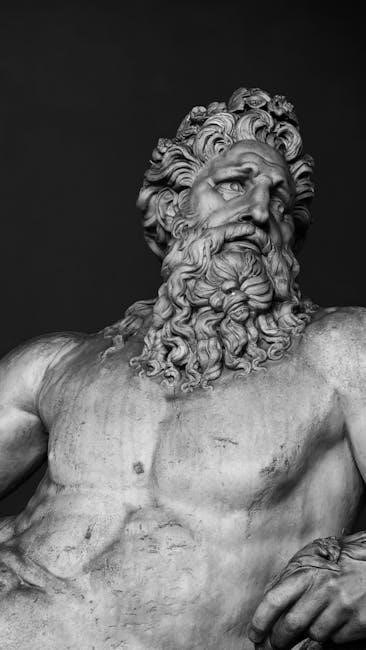D’Aulaires’ Book of Greek Myths is a timeless collection of ancient Greek stories, vividly illustrated and masterfully retold. Available as a PDF, it introduces readers to gods, heroes, and legendary tales, blending education with enchantment. Authored by Ingri and Edgar Parin d’Aulaire, this beloved book has captivated generations since its 1962 publication, offering a gateway to Greek mythology’s rich cultural heritage.
1.1 Overview of the Book
D’Aulaires’ Book of Greek Myths is a captivating retelling of ancient Greek mythology, authored by Ingri and Edgar Parin d’Aulaire. First published in 1962, the book has become a cornerstone of children’s literature, blending engaging storytelling with rich cultural insights. The d’Aulaires’ unique narrative style brings to life the gods, goddesses, and legendary figures of Greece, such as Zeus, Athena, and Hercules, while their intricate illustrations add depth and visual charm. The book is structured to introduce young readers to the origins of Greek myths, the relationships between gods and mortals, and the timeless lessons embedded in these stories. Available in PDF format, the digital version retains the original’s magic, offering a portable and accessible way to explore these classic tales. With its enduring popularity, the book remains a cherished resource for both children and adults, fostering a love for mythology and history. Its updated editions include new features like an afterword and previously unpublished sketches, enhancing its appeal for modern readers.

1.2 Historical Context and Significance
D’Aulaires’ Book of Greek Myths holds a special place in the history of children’s literature, first published in 1962 during a time when mythology was gaining popularity in educational and storytelling contexts. The book’s significance lies in its ability to make Greek mythology accessible and engaging for young readers, while maintaining the richness and complexity of the original tales. Authored by Ingri and Edgar Parin d’Aulaire, the book reflects their deep research and artistic interpretation of Greek culture, influenced by their travels to Greece. Its publication marked a turning point in how mythology was presented to children, blending education with entertainment. The book’s enduring popularity over six decades underscores its importance as a cultural and educational resource. Available in PDF format, it continues to introduce new generations to the timeless stories of ancient Greece, ensuring the legacy of Greek mythology remains vibrant and relevant in modern times.
Authors: Ingri and Edgar Parin d’Aulaire
Ingri and Edgar Parin d’Aulaire were a renowned author-illustrator duo. Their collaboration brought Greek mythology to life in D’Aulaires’ Book of Greek Myths, available as a PDF. Their storytelling and artistic skills captivated readers.
2.1 Biographies of the Authors
Ingri and Edgar Parin d’Aulaire were a husband-and-wife team renowned for their collaborative work in children’s literature. Ingri was born in 1904 in Kongsberg, Norway, while Edgar was born in 1898 in Munich, Germany. They met in Paris, where they both studied art, and later married. Their shared passion for storytelling and art led them to create books that blended vivid illustrations with engaging narratives.
Their most famous work, D’Aulaires’ Book of Greek Myths, was published in 1962 and has since become a classic. The book’s success stems from their unique ability to simplify complex myths while retaining their essence. Their collaboration extended beyond writing; Edgar’s detailed illustrations complemented Ingri’s storytelling perfectly. The d’Aulaires’ work has been praised for its ability to make mythology accessible to children and adults alike. Their legacy continues to inspire new generations of readers and illustrators.
- Ingri d’Aulaire (1904–1980) was a skilled writer and artist.
- Edgar Parin d’Aulaire (1898–1986) was a talented illustrator and artist.
- Their collaboration resulted in timeless children’s literature.
- Their work on Greek myths remains their most enduring contribution.
2.2 Their Approach to Mythology

Ingri and Edgar Parin d’Aulaire approached mythology with a unique blend of artistic and narrative excellence. Their work on D’Aulaires’ Book of Greek Myths reflects a deep respect for the cultural and historical significance of the stories. They immersed themselves in Greek culture, studying its landscapes, artifacts, and traditions, which inspired their detailed illustrations and authentic storytelling.
Their approach was to simplify complex myths while preserving their essence, making them accessible to children. The d’Aulaires believed in the educational value of mythology, using it to teach moral lessons and cultural heritage. Their illustrations, often described as lavish and intricate, complemented the narratives, creating a visually engaging experience.
- They emphasized the cultural and historical context of the myths.
- Their illustrations were integral to the storytelling process.
- They balanced simplicity with depth to appeal to both children and adults.
Their method ensured that the myths remained timeless, fostering a love for mythology in readers of all ages.

Content and Structure of the Book
D’Aulaires’ Book of Greek Myths masterfully organizes timeless stories of gods, heroes, and legendary creatures. With vivid illustrations and engaging narratives, it balances entertainment and education, making Greek mythology accessible and captivating for young readers.
3.1 Key Myths and Stories Included
D’Aulaires’ Book of Greek Myths presents a comprehensive collection of ancient Greek stories, featuring iconic figures like Zeus, Athena, Apollo, and Dionysus. It includes tales of legendary heroes such as Hercules, Theseus, and Perseus, as well as the captivating stories of Pandora, Prometheus, and Orpheus. The book also delves into the myths of the Trojan War, the labyrinth of the Minotaur, and the tragic story of Persephone and Demeter. Each narrative is enriched with vivid descriptions of gods, mortals, and mythical creatures, bringing the ancient world to life. The d’Aulaires’ rendition of these myths is both faithful to their origins and accessible to young readers, making it a cherished resource for exploring Greek mythology. The inclusion of maps and historical context further enhances the reader’s understanding of the stories’ cultural and geographical significance.
3.2 Organization and Narrative Style
D’Aulaires’ Book of Greek Myths is meticulously organized, presenting stories in a logical and engaging sequence. The book begins with the origins of the world and the rise of the Olympian gods, followed by tales of legendary heroes and their quests. This chronological structure helps readers understand the interconnectedness of Greek mythology. The narrative style is clear and accessible, making complex myths understandable for young audiences while retaining their richness. The d’Aulaires’ prose is lively and vivid, with detailed descriptions of characters and events that captivate readers. The inclusion of maps and visual references further enhances the storytelling, providing context for the geographical and cultural settings of the myths. This approach ensures that the book is both educational and entertaining, making it a beloved resource for introducing children to the wonders of Greek mythology.
3.3 Cultural and Historical Significance
D’Aulaires’ Book of Greek Myths holds profound cultural and historical significance as a timeless introduction to ancient Greek mythology. The book preserves the rich heritage of Greek myths, making them accessible to younger generations while maintaining their original depth and complexity. By retelling stories of gods, goddesses, and heroes, the d’Aulaires have ensured that these tales remain relevant in modern times. The inclusion of maps and historical context adds layers of educational value, helping readers connect the myths to their cultural and geographical origins. The book’s enduring popularity underscores its role in shaping understanding of classical civilization. Its influence extends beyond academia, inspiring countless adaptations in literature, art, and popular culture. As a result, D’Aulaires’ Book of Greek Myths is not only a cherished literary work but also a vital bridge between ancient traditions and contemporary audiences.
3.4 Educational Value for Children
D’Aulaires’ Book of Greek Myths is widely regarded for its exceptional educational value, making it a cornerstone in children’s literature. The book introduces young readers to the fascinating world of Greek mythology through engaging storytelling and vivid illustrations, sparking curiosity and a love for learning. By presenting complex myths in an accessible and relatable manner, the d’Aulaires help children develop critical thinking and creativity. The inclusion of moral lessons, historical context, and cultural insights enriches the learning experience, teaching kids about ethics, bravery, and the human condition. The book’s ability to balance entertainment with education makes it a valuable resource for both homeschooling and classroom settings. Its timeless appeal ensures that children not only gain knowledge but also develop a deeper appreciation for mythology and its influence on art, literature, and culture. This makes D’Aulaires’ Book of Greek Myths a treasured tool for fostering intellectual growth and imagination in young minds.
Illustrations in the Book
The illustrations in D’Aulaires’ Book of Greek Myths are renowned for their intricate detail and vibrant style, crafted by Caldecott-winning artists Ingri and Edgar Parin d’Aulaire. Their lavish depictions bring gods, goddesses, and mythical creatures to life, enhancing the storytelling and captivating young readers. The PDF version preserves these iconic visuals, ensuring the book’s artistic charm remains intact for digital audiences.
4.1 Style and Technique
The illustrations in D’Aulaires’ Book of Greek Myths are celebrated for their unique style and meticulous technique. Created by Ingri and Edgar Parin d’Aulaire, the artwork blends traditional lithography with a modern, expressive approach. The detailed drawings bring ancient Greek gods, goddesses, and mythical creatures to life, capturing their grandeur and humanity. The d’Aulaires’ use of bold lines, vibrant textures, and dynamic compositions creates a visually stunning narrative that complements the stories. Their work, inspired by Greek architecture and artifacts, reflects a deep respect for the subject matter. The illustrations are both educational and enchanting, making the myths accessible to children while maintaining artistic sophistication. The PDF version of the book preserves the original artwork’s clarity, ensuring that digital readers can appreciate the timeless beauty of the d’Aulaires’ craft. Their style has become iconic in children’s literature, setting a high standard for illustrated mythology books.
4.2 Role of Illustrations in Storytelling
The illustrations in D’Aulaires’ Book of Greek Myths play a pivotal role in bringing ancient Greek mythology to life. Ingri and Edgar Parin d’Aulaire’s artwork is not merely decorative but integral to the storytelling, offering visual narratives that enhance the text. Their detailed lithographs depict gods, goddesses, and mythical creatures with precision, making complex stories accessible and engaging for readers of all ages. The illustrations provide context, convey emotions, and highlight the grandeur of the myths, allowing readers to visualize the characters and settings vividly. For example, Zeus’s power is captured through dynamic poses and expressions, while scenes of mythical creatures evoke a sense of wonder. The PDF format ensures that these illustrations retain their clarity and impact, making the digital version as immersive as the original. By blending art and storytelling, the d’Aulaires’ illustrations create a lasting connection to the myths, fostering both education and enchantment.

Reception and Reviews
D’Aulaires’ Book of Greek Myths has received widespread acclaim for its engaging storytelling and vibrant illustrations. Readers praise its ability to make Greek mythology accessible and entertaining, while the PDF format ensures its timeless appeal endures across generations.

5.1 Initial Reception Upon Publication

Upon its release in 1962, D’Aulaires’ Book of Greek Myths received widespread critical acclaim for its captivating storytelling and stunning illustrations. Critics praised the d’Aulaires’ ability to retell ancient myths with clarity and charm, making them accessible to both children and adults. The book’s vibrant visuals, crafted by Caldecott-winning authors Ingri and Edgar Parin d’Aulaire, were particularly celebrated for their detail and artistry. Educators and parents alike commended the work for its educational value, as it introduced young readers to the rich cultural heritage of Greek mythology. The PDF version, now widely available, has further enhanced the book’s reach, ensuring its timeless appeal. Its enduring popularity since publication underscores its significance as a beloved resource for exploring the world of gods, heroes, and legendary tales.
5.2 Enduring Popularity and Impact
D’Aulaires’ Book of Greek Myths has maintained its status as a cherished classic, with its popularity enduring for over six decades. The book’s ability to captivate readers of all ages has solidified its place in children’s literature. Its influence extends beyond entertainment, as it has become a foundational resource for introducing Greek mythology to young minds. The availability of the PDF version has further amplified its reach, allowing new generations to access and appreciate the timeless stories. Many authors and educators credit the book as a pivotal influence in their work, highlighting its lasting impact on both literature and education. The d’Aulaires’ unique storytelling and artistic style continue to inspire, ensuring that their work remains a cornerstone of cultural and educational enrichment.
Legacy of D’Aulaires’ Book of Greek Myths
D’Aulaires’ Book of Greek Myths has left an indelible mark on children’s literature, educating and enchanting readers for generations. Its PDF availability ensures continued accessibility, making it a timeless resource for exploring Greek mythology’s cultural and historical significance.

6.1 Influence on Children’s Literature
D’Aulaires’ Book of Greek Myths has profoundly shaped children’s literature by blending education with storytelling. Its vivid narratives and stunning illustrations set a new standard for presenting mythology to young readers. The book’s ability to make complex myths accessible and engaging has inspired countless authors and educators. Many credit it with sparking a lifelong interest in mythology and history. The PDF version ensures its timeless stories reach modern audiences, maintaining its relevance in digital age. Its influence is evident in how it balances cultural depth with child-friendly language, making it a benchmark for children’s nonfiction. The d’Aulaires’ approach has encouraged other creators to adapt classical tales for younger readers, ensuring the legacy of Greek myths endures. This book remains a cornerstone of children’s literature, proving that mythology can be both entertaining and educational. Its impact continues to resonate, shaping how stories from ancient Greece are shared with new generations.
6.2 Continued Relevance in Modern Times
D’Aulaires’ Book of Greek Myths remains a vital resource in modern times, offering timeless stories that captivate readers of all ages. Its enduring popularity stems from its ability to bridge ancient mythology with contemporary interests. The PDF format has made it easily accessible, ensuring that digital generations can explore the tales of Zeus, Athena, and other legendary figures. The book’s vivid storytelling and moral lessons continue to resonate, teaching children about courage, wisdom, and the human condition. Its cultural significance is undeniable, as it introduces young readers to the roots of Western civilization. Authors like R.J. Palacio have credited the book with inspiring their own work, highlighting its lasting impact. The d’Aulaires’ masterpiece not only educates but also entertains, making it a cherished resource for families and educators alike. Its relevance in modern times lies in its universal themes and its ability to spark imagination while preserving the richness of Greek mythology for future generations.

Digital Availability and PDF Versions
D’Aulaires’ Book of Greek Myths is widely available in PDF format, offering convenient access to its timeless stories. Readers can download it for free from platforms like Z-Library or purchase it from various digital bookstores. The PDF version ensures that the book’s vibrant illustrations and engaging narratives remain intact, making it a popular choice for both children and adults. Its digital format allows for easy reading on devices like tablets, phones, and e-readers, ensuring that the classic tales of Greek mythology are accessible to modern audiences worldwide.
7.1 Sources for Downloading the PDF
The PDF version of D’Aulaires’ Book of Greek Myths is readily available from various online sources. Platforms like Z-Library and BYU ScholarsArchive offer free downloads, making it accessible to a wide audience. Additionally, the book can be found on websites such as Issuu and Internet Archive, where users can either download the PDF or read it online. Some platforms may require registration or subscription for access, but many provide the file for free. The PDF format ensures that the book’s illustrations and text remain intact, preserving the original experience. Readers can also find the PDF through digital bookstores like Amazon or Barnes & Noble, where it may be available for purchase. These sources make it easy for both children and adults to enjoy the timeless stories of Greek mythology in a convenient digital format.
7.2 Benefits of the Digital Format
The digital format of D’Aulaires’ Book of Greek Myths offers numerous advantages for modern readers. The PDF version is easily accessible across devices, including smartphones, tablets, and computers, making it convenient for on-the-go reading. Its digital nature allows for features like bookmarks, note-taking, and highlighting, enhancing the reading experience. The file is also space-saving, eliminating the need for physical storage. Additionally, the PDF preserves the book’s vibrant illustrations and clear text, ensuring an immersive experience. Many platforms offer free downloads, making it accessible to a wide audience. The digital format also reduces the environmental impact compared to printing physical copies. Furthermore, the PDF can be easily shared among users, promoting accessibility and fostering a love for Greek mythology across generations. Overall, the digital version of D’Aulaires’ Book of Greek Myths combines convenience, functionality, and sustainability, making it a preferred choice for many readers.
D’Aulaires’ Book of Greek Myths remains a timeless treasure, offering insights into ancient Greek culture and captivating readers of all ages. Its availability in PDF format ensures accessibility, preserving its legacy for future generations to explore and cherish.
8.1 Summary of the Book’s Importance

D’Aulaires’ Book of Greek Myths holds a significant place in both children’s literature and classical education. Its masterful retelling of ancient Greek myths, combined with stunning illustrations, has made it a beloved resource for introducing young readers to the rich cultural heritage of Greek mythology. The book’s ability to balance detailed storytelling with accessibility ensures that it appeals to a wide audience, from children to adults. Its educational value lies in its faithful representation of the myths, which not only entertain but also provide insights into the beliefs and values of ancient Greek civilization. The d’Aulaires’ unique approach to mythology, blending historical accuracy with artistic flair, has cemented the book’s status as a timeless classic. Furthermore, its availability in PDF format has made it more accessible to modern readers, ensuring its continued relevance and reach in the digital age. This book remains a vital tool for fostering a love of mythology and history in readers of all ages.
8.2 Final Thoughts on Its Timeless Appeal
D’Aulaires’ Book of Greek Myths endures as a captivating gateway to ancient Greek mythology, charming readers with its vivid storytelling and iconic illustrations. The d’Aulaires’ ability to weave complex myths into engaging narratives has made the book a cherished resource for both children and adults; Its timeless appeal lies in its universal themes—heroism, morality, and the human condition—rendered through the lens of gods and mortals. The availability of the book in PDF format has further enhanced its accessibility, allowing new generations to discover its magic. The illustrations, rich in detail and imagination, transport readers to a world of wonder, while the stories themselves foster a deeper understanding of Western cultural roots. This book is not merely a retelling of myths but a bridge between the past and present, ensuring that the lessons and enchantment of Greek mythology continue to resonate. Its enduring popularity is a testament to the d’Aulaires’ mastery of their craft and the eternal allure of these timeless tales.
